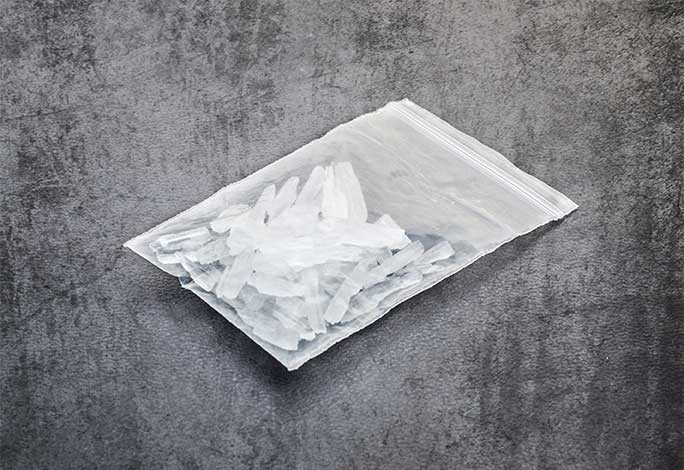Crystal Meth: Facts, Signs Of Abuse & Addiction

Medically Reviewed By: Kimberly Langdon, M.D.
Crystal meth is an addictive stimulant drug that produces an extended, euphoric, and energetic high followed by a severe comedown and crash. Long-term, meth use will likely degrade the body and mind in damaging ways.

Crystal methamphetamine is a powerful and long-acting synthetic stimulant drug known for causing severe drug addiction and extreme physical and mental harm in those who abuse it.
Effects Of Crystal Meth
Methamphetamine is a derivative of amphetamine, a stimulant drug used to treat medical conditions including ADHD (attention-deficit hyperactivity disorder) and narcolepsy.
As a Schedule II controlled substance, methamphetamine can also be legally prescribed for these uses in uncommon instances. But pharmaceutical methamphetamine is rare and tightly controlled, while crystal meth is cooked in highly toxic, secretive meth labs either in the United States or foreign countries.
When used, crystal meth floods the brain with dopamine, a neurotransmitter responsible for pleasure and reward. This also sends the body and mind racing in a euphoric rush and long-lasting high, followed by an equally severe comedown or crash afterwards.
Short-Term Signs Of Crystal Meth Use
The immediate effects of meth on the central nervous system will likely impact how a person thinks and behaves in noticeable and often bizarre ways. Common signs of methamphetamine drug use include:
- moving constantly
- loss of appetite
- racing thoughts
- talking rapidly
- acting with intense confidence and without inhibition
- unpredictable and aggressive behavior
- paranoia
- increased wakefulness
- increased body temperature, blood pressure, heart rate, and breathing rate
These effects usually last between 6 to 12 hours for a single dose, with swallowing or snorting having a slower onset and smoking and injection having a much faster onset of effect.
Binging & Crashing
As the drug wears off, a methamphetamine high likely gives way to a comedown and symptoms that can include confusion, pain, fatigue, apathy, heartburn, nausea, anxiety, and depression.
To temporarily avoid these feelings, many people continue their methamphetamine abuse in repeated cycles that can last for days at a time, known as a binge.
However, with each cycle the pleasurable effects of crystal meth use diminish, and the body grows more exhausted, hungry, dehydrated, and weak until a person reaches a stage known as a crash or tweaking.
Tweaking can be identified by:
- psychosis and disconnection from reality
- intense cravings
- hallucinations
- severe paranoia or panic
- picking or digging at the skin of the face or arms
- extended periods of sleep
Crystal Meth Paraphernalia
Common methamphetamine paraphernalia includes:
- glass pipes
- scorched spoons
- burnt aluminum foil
- straws or rolled up bills paper
- needles and/or syringes
- shoelaces or rubber tubing
- mirrors or other glass surfaces
- razorblades or credit cards
Crystal Meth Street Names
Street names for crystal meth generally reference either the appearance or effects of meth, and include Tina, speed, zoom, go, crank, tweak, ice, glass, and others.
Signs Of Methamphetamine Overdose
In cases of a meth overdose, the effects of methamphetamine can overwhelm the body’s normal, life-sustaining functions. This can suddenly trigger a variety of serious or life-threatening side effects including:
- overheating
- irregular heartbeats
- heart attack
- stroke
- seizures
- delirium
- other organ failure
Speedball Overdose
Many fatal methamphetamine overdoses also occur due to the combination use of methamphetamine with opioid drugs like heroin or fentanyl. However, the push/pull effects of these opposing, highly addictive drugs can be exceedingly toxic and unpredictable.
This may change the signs and symptoms of an overdose considerably.
Long-Term Symptoms Of Crystal Meth Addiction
The long-term effects of chronic methamphetamine addiction often include:
- unhealthy weight loss and wasting
- severe tooth decay and gum disease (“meth mouth”)
- insomnia
- fatigue
- premature aging
- cardiovascular injury
- frequent illness
- psychotic episodes
- nervous activity, like scratching or picking at the skin
- frequent irritability and mood swings
- mental health issues often including anxiety, depression, paranoia, and memory loss
- tics, tremors, or convulsions
- birth defects in the event of pregnancy
Diagnosing Methamphetamine Addiction
Even developing 2-3 of the following criteria, described in the DSM-5, can indicate the development of a diagnosable substance use disorder, more commonly known as addiction:
- taking more meth than you intended
- sometimes wanting to use less meth or go drug-free, but failing to
- devoting increasing time to getting, using, or recovering from meth use
- experiencing meth cravings
- falling behind in your personal responsibilities because of meth use
- experiencing negative effects in your personal relationships
- avoiding other important activities to take the drug
- using meth in high-risk situations
- using meth despite it potentially worsening other physical or psychological problems
- taking a higher and higher dosage due to increasing tolerance
- experiencing unpleasant withdrawal symptoms when you stop using meth
Meth Addiction Treatment
Substance use disorders, including methamphetamine addiction, are treatable behavioral disorders. But the process of recovery can be a long and difficult one, and relapses are common.
If you or a loved one struggles with methamphetamine use, consider a personalized substance abuse treatment program hosted by Ohio Recovery Center.
Our leading treatment options include medical detox, intensive inpatient treatment, dual diagnosis care for other co-occurring disorders, cognitive behavioral therapy, and more.
For more information, please reach out to our professional staff today.
- American Psychiatric Association — Substance-Related and Addictive Disorders https://psychiatry.org/File%20Library/Psychiatrists/Practice/DSM/APA_DSM-5-Substance-Use-Disorder.pdf
- Drug Enforcement Administration (DEA) — Drug Fact Sheet: Methamphetamine https://www.dea.gov/sites/default/files/2020-06/Methamphetamine-2020_0.pdf
- National Institute on Drug Abuse (NIDA) — Methamphetamine DrugFacts https://nida.nih.gov/publications/drugfacts/methamphetamine
- National Library of Medicine: MedlinePlus — Methamphetamine overdose https://medlineplus.gov/ency/article/007480.htm

